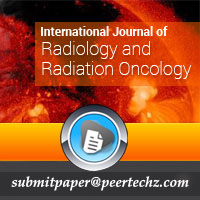International Journal of Radiology and Radiation Oncology
PSMA Accumulation in Benign Pleural Thickening
Kevser Oksuzoglu1,4*, Ilknur Alsan Cetin2, Feyza Sen3, Tunc Ones1, Reza Maleki1, Halil Turgut Turoglu1 and Tanju Yusuf Erdil1
2Department of Radiation Oncology, Marmara University Pendik Training and Research Hospital, Istanbul, Turkey
3Department of Nuclear Medicine, Uludag University School of Medicine, Bursa, Turkey
4Fevzi Çakmak Mahallesi Muhsin Yazıcıoglu Caddesi No:10, Üst, Kaynarca/Pendik/İstanbul, Turkey
Cite this as
Oksuzoglu K, Cetin IA, Sen F, Ones T, Maleki R, et al. (2016) PSMA Accumulation in Benign Pleural Thickening. Int J Radiol Radiat Oncol 2(1): 023-024. DOI: 10.17352/ijrro.000016Prostate-specific membrane antigen (PSMA) is a specific type II membrane glycoprotein. We present the case of a 72-year-old man with newly diagnosed prostate cancer who had a 68Ga-PSMA PET/CT scan for staging. 68Ga-PSMA PET/CT images showed moderate uptake in the right hemithorax, corresponding to pleural thickening seen on the CT images. Histopathologic examination revealed the diagnosis of chronic inflammation. It is important to keep in mind other alternative diagnoses such as chronic inflammation when 68Ga-PSMA PET/CT identifies uptake at an atypical site.
Clinical Image
A 72-Year-Old man with newly diagnosed prostate cancer (PSA:12.47ng/ml, Gleason score:3+3) underwent skeletal scintigraphy before treatment. Suspicious Tc-99m MDP uptake was seen on right hemithorax (Figure 1A). Due to suspicious Tc-99m MDP uptake on right hemithorax on bone scintigraphy, further investigation using 68Ga-PSMA PET/CT was suggested. 68Ga-PSMA PET/CT revealed increased heterogeneous uptake in the right posterolateral segment of prostate gland compatible with prostate needle biopsy findings (adenocarcinoma). 68Ga-PSMA PET/CT images showed non-expected slightly increased uptake (SUVmax:1.6) in the right hemithorax greater than mediastinal blood pool activity (SUVmax:1.2), corresponding to pleural thickening seen on the CT images (first intercostals space (Figure 1B) and neighbourhood of the 4 and 6 rib (Figure 1C) with normal lung parenchyma. Thoracoscopic biopsy was performed to establish a definitive diagnosis. The results of histopathological examination (excisional biopsy) indicated the features of chronic inflammation with focal mesothelial hyperplasia. There was no evidence of stromal invasion.
Prostate-specific membrane antigen (PSMA) is a specific type II membrane glycoprotein and its expression is suppressed by androgen in prostate cancer. PSMA is a promising target for both therapy with monoclonal antibodies and imaging [1-3].
PSMA is not specific to the epithelium of prostate gland and is expressed in normal other tissues too, for example urinary bladder, proximal tubules of kidney, liver, salivary glands, oesophagus, stomach, small intestine and neuroendocrine cells in the colon. Some malignant lesions such as adrenocortical carcinoma and some benign lesions (schwannomas) can cause abnormal PSMA-ligand uptake that may be confused with metastases [4-6]. Also, PSMA is expressed in non-neoplastic reparative and regenerative neovasculature tissues like endothelial cells in keloids, granulation tissue from heart valves and pleura, and different phases of cycling endometrium [7].
Chronic inflammation should be kept in mind when interpreting whole-body 68Ga-PSMA PET/CT images and 68Ga-PSMA avid lesions should be confirmed with tissue biopsy before treatment.
- Ghosh A, Heston WD (2004) Tumor target prostate specific membrane antigen (PSMA) and its regulation in prostate cancer. J Cell Biochem 91: 528–539.
- Noss KR, Wolfe SA, Grimes SR (2002) Upregulation of prostate specific membrane antigen/folate hydrolase transcription by an enhancer. Gene 285: 247–256.
- Evans MJ, Smith-Jones PM, Wongvipat J, Navarro V, Kim S, et al. (2011) Noninvasive measurement of androgen receptor signaling with a positron-emitting radiopharmaceutical that targets prostate specific membrane antigen. Proc Natl Acad Sci USA 108: 9578-9582.
- Wright GL Jr, Haley C, Beckett ML, Schellhammer PF (1985) Expression of prostate-specific membrane antigen in normal, benign, and malignant prostate tissues. Urol Oncol 1: 18-28.
- Wang W, Tavora F, Sharma R, Eisenberger M, Netto GJ (2009) PSMA expression in Schwannoma: a potential clinical mimicker of metastatic prostate carcinoma. Urol Oncol 27: 525-528.
- Crowley MJ, Scognamiglio T, Liu YF, Kleiman DA, Beninato T, et al. (2016) Prostat-Specific Membrane Antigen Is a Potential Antiangiogenic Target in Adrenocortical Carcinoma. J Clin Endocrinol Metab 101: 981-987.
- Gordon IO, Tretiakova MS, Noffsinger AE, Hart J, Reuter VE, et al. (2008) Prostate-specific membrane antigen expression in regeneration and repair. Mod Pathol 21: 1421-1427
Article Alerts
Subscribe to our articles alerts and stay tuned.
 This work is licensed under a Creative Commons Attribution 4.0 International License.
This work is licensed under a Creative Commons Attribution 4.0 International License.


 Save to Mendeley
Save to Mendeley
